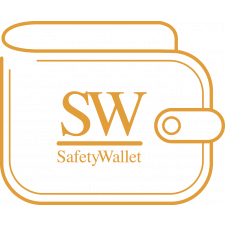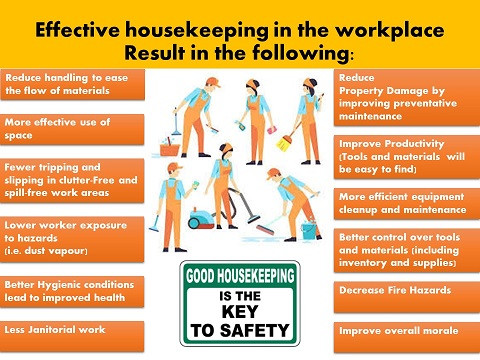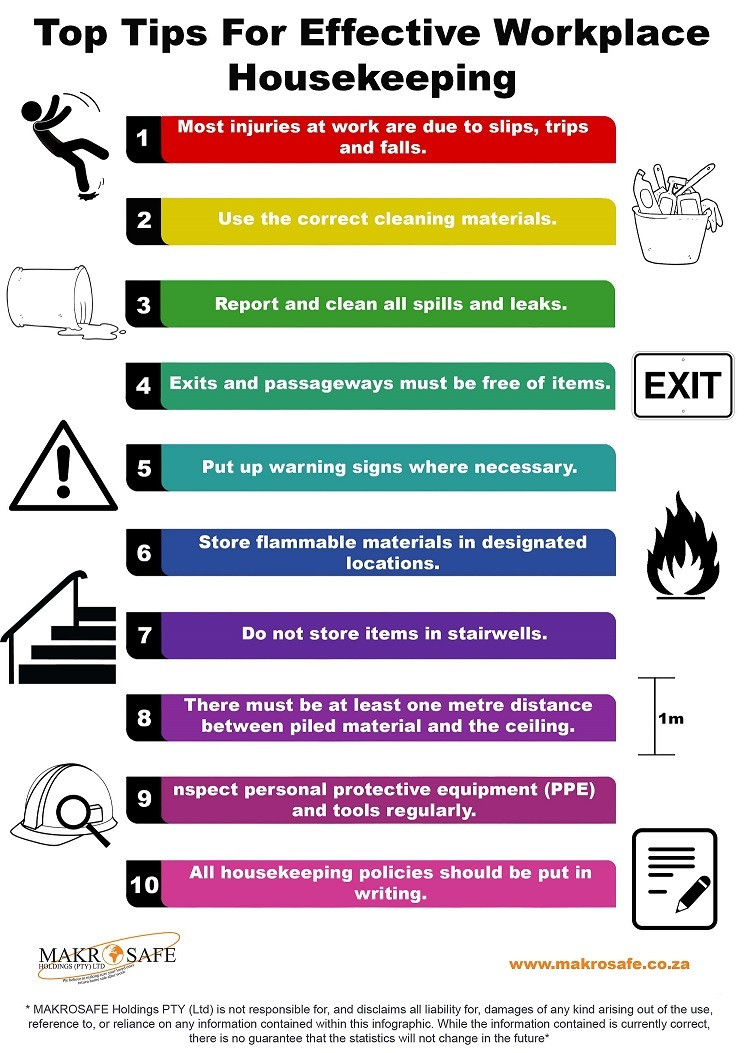Good housekeeping in the Workplace
A starting point for effective housekeeping and cleanliness in the workplace is the setting of the housekeeping and cleanliness practices and then training the employees in those practices. These practices are to have clear objectives which are practical and attainable. The practices are to comply with the regulatory norms and requirements. These practices are to be safe and simple so that employees are motivated to follow them.
MAKROSAFE in Partnership with SafetyWallet has the perfect solution for implementing your Health and Safety Programme.
Click on the picture below to choose a Health and Safety Programme to suit your needs:
Good housekeeping and cleanliness practices in the workplace:
Plan and manage an orderly storage and movement of materials from point of entry to exit. They include a material flow plan which ensures minimal handling. The plan also ensures that work areas are not used as storage areas. This avoids the employees moving the materials to and from work areas as needed.
Part of the plan can include an earmarked area for different materials and frequency of material disposal from the earmarked area. This step at workplace results into the elimination of repeated handling of the same material and more effective use of the employee's time. Often, ineffective or insufficient storage planning results in materials being handled and stored in hazardous ways. Knowing the shop layout and the movement of materials throughout the workplace helps in planning of the work procedures.
Employee’s OHS Training is an essential part of good housekeeping and cleanliness practice. Employees need to know how to work safely with the products they use. They also need to know how to protect other employees such as by posting signs, such as ‘wet - slippery floor’ etc. and reporting any unusual conditions.
The practices of housekeeping and cleanliness in the workplace are to be ‘maintained and not ‘achieved’. To be effective, these practices are to be used on a regular and continual basis by the employees in the organisation. One way to ensure that these practices are followed at the workplace is to integrate them with the job responsibilities of the employees.
For housekeeping and cleanliness practices, special attention is needed for the places which are ‘out-of-the-way’ or which are unmanned since without special attention to these places are likely to be overlooked. The orderly arrangement of operations, tools, equipment and supplies is an important part of a good housekeeping cleanliness practices. Also, regular Health and Safety Inspections are needed for ensuring that the practices are followed at the workplace.
How can a Risk Assessment help with poor housekeeping in the workplace
By conducting a risk assessment, employers can identify areas of poor housekeeping in the workplace and take steps to improve them. For example, a risk assessment may reveal that a cluttered work area is blocking emergency exits, making it difficult for workers to evacuate in case of fire. Or it might show that an area where chemicals are stored is not properly labeled, increasing the risk of accidental exposure. Once these hazards are identified, the employer can take action to address them, such as by establishing a cleaning and organization schedule, installing proper signage, or providing training on safe storage of chemicals. Overall, a risk assessment can help improve poor housekeeping by identifying and addressing potential hazards before they cause harm.
For all your Health and Safety needs, please click on the picture below:
MAKROSAFE / SAFETYWALLET / MY SAFETY SHOP are all in Partnership
Click on the image below to view our SafetyWallet Subscription Package to suit your Business:
Effective and good housekeeping practices in the workplace can eliminate some hazards and help get a job done safely and properly. Poor housekeeping can frequently contribute to accidents by hiding hazards that cause injuries. If the sight of paper, debris, clutter and spills is accepted as normal, then other more serious health and safety hazards may be taken for granted.
Housekeeping is not just cleanliness. It includes keeping work areas neat and orderly; maintaining halls and floors free of slip and trip hazards; and removing of waste materials (paper, cardboard) and other fire hazards from work areas.
It also requires paying attention to important details such as the layout of the whole workplace, aisle marking, the adequacy of storage facilities, and maintenance. Good housekeeping is also a basic part of accident and fire prevention.
Effective housekeeping is an ongoing operation: it is not a hit-and-miss cleanup done occasionally. Periodic “panic” cleanups are costly and ineffective in reducing accidents.
Effective housekeeping results in:
Reduced handling to ease the flow of materials
Fewer tripping and slipping accidents in clutter-free and spill-free work areas
Decreased fire hazards
Lower worker exposure to hazardous substances (e.g. dusts, vapours)
Better control of tools and materials, including inventory and supplies
More efficient equipment cleanup and maintenance
Better hygienic conditions leading to improved health
More effective use of space
Reduced property damage by improving preventative maintenance
Less janitorial work
Improved morale
Improved productivity, tools and materials will be easy to find.
How can a Health and Safety Compliance Audit help with poor housekeeping?
By conducting a health and safety compliance audit, employers can identify areas of poor housekeeping in the workplace and take steps to improve them. For example, during an audit, an inspector may observe that a work area is cluttered, blocking emergency exits or creating trip hazards. Or it might find that machinery or equipment are not properly maintained and create dust or other airborne contaminants. By identifying these hazards during an audit, employers can then take action to address them and make the work environment safer for employees. The Audit can also help prioritize the areas of poor housekeeping and help management to establish a schedule for cleaning and maintenance in the workplace. Additionally, Compliance audits help employers to stay in compliance with safety regulations, reducing the risk of fines and penalties for non-compliance. Overall, a health and safety compliance audit can help improve poor housekeeping by identifying and addressing hazards and ensuring that the workplace is in compliance with relevant regulations.
Dust and Dirt Removal
In some jobs, enclosures and exhaust ventilation systems may fail to collect dust, dirt and chips adequately. Vacuum cleaners are suitable for removing light dust and dirt. Industrial models have special fittings for cleaning walls, ceilings, ledges, machinery, and other hard-to-reach places where dust and dirt may accumulate. Special-purpose vacuums are useful for removing hazardous substances. For example vacuum cleaners fitted with HEPA (high efficiency particulate air) filters may be used to capture fine particles of asbestos or fibreglass.
Dampening (wetting) floors or using sweeping compounds before seeping reduces the amount of airborne dust. The dust and grime that collect in places like shelves, piping, conduits, light fixtures, reflectors, windows, cupboards and lockers may require manual cleaning. Compressed air should not be used for removing dust, dirt or chips from equipment or work surfaces.
Employee Facilities
Employee facilities need to be adequate, clean and well maintained. Lockers are necessary for storing employees’ personal belongings. Washroom facilities require cleaning once or more each shift. They also need to have a good supply of soap, towels plus disinfectants, if needed.
If workers are using hazardous materials, employee facilities should provide special precautions such as showers, washing facilities and change rooms. Some facilities may require two locker rooms with showers between. Using such double locker rooms allows workers to shower off workplace contaminants and prevents them from contaminating their “street clothes” by keeping their work clothes separated from the clothing that they wear home.
Smoking, eating or drinking in the work area should be prohibited where toxic materials are handled. The eating area should be separate from the work area and should be cleaned properly after each shift.
Surfaces
Floors - poor floor conditions are a leading cause of accidents so cleaning up spilled oil and other liquids at once is important. Allowing chips, shavings and dust to accumulate can also cause accidents. Trapping chips, shavings and dust before they reach the floor or cleaning them up regularly can prevent their accumulation. Areas that cannot be cleaned continuously, such as entrance ways, should have anti-slip flooring. Keeping floors in good order also means replacing any worn, ripped, or damaged flooring that poses a tripping hazard.
Walls
Light coloured walls reflect light well dirty or dark coloured walls absorb light. Contrasting colours warn of physical hazards and mark obstructions such as pillars. Paint can highlight railings, guards and other safety equipment, but should never be used as a substitute for guarding. The programme should outline the regulations and standards for colours.
Maintain light fixtures
Dirty light fixtures reduce essential light levels. Clean light fixtures can improve lighting efficiency significantly.
Aisles and Stairways
Aisles should be wide enough to accommodate people and vehicles comfortably and safely. Aisle space allows for the movement of people, products and materials. Warning signs and mirrors can improve sight lines in blind corners. Arranging aisles properly encourages people to use them so that they do not take shortcuts through hazardous areas. Keeping aisles and stairways clear is important. They should not be used for temporary “overflow” or “bottleneck” storage. Stairways and aisles also require adequate lighting.
Spill Control
The best way to control spills is to stop them before they happen. Regularly cleaning and maintaining machines and equipment is one way. Another is to use drip pans and guards where possible spills might occur. When spills do occur, it is important to clean them up immediately. Absorbent materials are useful for wiping up greasy, oily or other liquid spills. Used absorbents must be disposed of properly and safely.
Waste Disposal
The regular collection, grading and sorting of scrap contribute to good housekeeping practices. It also makes it possible to separate materials that can be recycled from those going to waste disposal facilities. Allowing material to build up on the floor wastes tie and energy since additional time is required for cleaning it up. Placing scrap containers near where the waste is produced encourages orderly waste disposal and make collection easier. All waste receptacles should be clearly labelled recycled glass, plastic, scrap metal, etc.
Storage
Good organisation of stored materials is essential for overcoming material storage problems whether on a temporary or permanent basis. There will also be fewer strain injuries if the amount of handling is reduced, especially if less manual materials handling is required. The location of stockpiles should not interfere with work but they should still be readily available when required. Stored materials should allow at least one meter, or about three feet of clear space under sprinkler heads.
Stacking cartons and drums on a firm foundation and cross tying them, where necessary, reduces the chance of their movement. Stored materials should not obstruct aisles, stairs, exits, fire equipment, emergency eyewash fountains, emergency showers, or first aid stations. All storage areas should be clearly marked.
Flammable, combustible, toxic and other hazardous materials should be stored in approved containers in designated areas that are appropriate for the different hazards that they pose. Storage of materials should meet all requirements specified in the fire codes and the regulations of environmental and occupational health and safety agencies in your jurisdiction.
Poor Housekeeping and Consequences
Some of the most common examples of poor housekeeping in the workplace e.g. Untidiness, disorder, poor storage of materials and stock. On many workplace inspection visits, one can usually see dirt and dust on the workbenches, light fittings and floors etc.
One of the most common findings in workplaces is poor housekeeping that include:
Untidiness
Disorder
Poor storage of materials and stock
Generally speaking, a cleaning programme appears to take place on an occasional ad-hoc basis. Such clutter not only reduces productivity by “blocking” the smooth flow of materials through the workplace, it can often present a fire hazard as boxes, trimmings and other combustible material is strewn on the premises.
Apart from encouraging vermin and their associated health hazards, it is also a sign of inefficiency and waste. Workplaces which have introduced regular cleaning programmes using industrial vacuum cleaners for example, not only reduce levels of dust and dirt in the workplace, but also improve the general working environment and workers health.
In addition they reduce maintenance costs as the machines remain cleaner for longer periods. There is less absenteeism through sickness. Ultimately the factory has a competitive advantage through improved productivity.
Consequences of Poor Housekeeping In the Workplace
Housekeeping sets the tone. If the workplace doesn’t focus on housekeeping, employees, vendors and others will not care about it or any other area requiring purposeful action not narrowly related to “production”. Therefore, you can assume that continuous quality improvement won’t readily occur, and safety processes will only be written procedures with little day-to-day effect on work.
Some construction studies conclude that on a “messy” job site, materials get moved and re-staged six to seven times for no good reason. How can you instill accountability in your front line supervision, and how can you build an engaged employee culture where employees do the “right thing” regardless of whether someone is watching them? Seemingly little thinks matter.









Comments (15)
Great thing that you also point out the proper waste disposal. This is one important step towards cleanliness. Not to mention the amount your company will save if you all learned about recycling.
2022-12-01 01:58:26Dear Adam Thank you for your feedback in comment, we really do appreciate it... Kindly follow this link to read all about our Occupational Hygiene Services you may require for your business: https://www.makrosafe.co.za/OccupationalHygieneServices
2022-12-09 10:43:26Well written blog with very important points. Many thanks.
2022-01-20 08:47:02Nice article Thanks for sharing this informative post, Keep posting!
2022-07-06 10:25:39I always look forward to reading your articles. You obviously put a lot of effort into this post, and I appreciate that.
2022-09-28 04:34:50Good Day Thank you for taking your time o read our blogs and also for your compliment in our comments... Kindly follow this link for a free download of a competent person guideline: https://www.mysafetyshop.co.za/Products/Free-Download---Competent-Person-Guideline
2022-12-09 10:49:000840273353
2023-05-24 07:31:11Good Day Smangele Thank you for reaching out, as discussed in our telecon, we currently have no job vacancies...
2023-05-25 08:38:37Brilliant Blog!! Thank you Basil.
2022-02-21 11:28:03Insightful thank you. a workplace with out incidents and Health and Safety Compliance start with good Housekeeping principles. Thank you
2022-02-21 22:04:15Insightful thank you. a workplace with out incidents and Health and Safety Compliance start with good Housekeeping principles. Thank you
2022-02-21 22:04:20I appreciate your insight. Good housekeeping practices are the foundation of a workplace free of incidents and compliant with health and safety regulations. Many thanks.
2022-10-06 00:10:31Dear Oswald Thank you for taking your time to read our blog, we really do appreciate it... To verify that your workplace is compliant, follow this link and select the correct Health and Safety Compliance Audit based on your site staff count, follow the prompts to place an order: https://www.mysafetyshop.co.za/Shop/Category/Health-and-Safety-Audit
2022-12-09 10:53:00Thank you for giving such valuable information. Your blog was extremely good I really appreciated this. To get more information on good housekeeping workplace
2022-10-07 12:31:45Room Attendant Uniform is a simple and enjoyable way to dress up. https://www.desirenation.com/room-attendant-uniform/
2022-12-25 11:35:06very informative thank you very much
2022-05-18 13:40:14I'm one your reader and always wanted to strart my own Cleaning Service. This is something that could be a great reference.
2023-01-15 06:19:54Good Housekeeping can prevent so many injuries.Awesome read.
2022-04-13 11:17:46I'm hard work
2024-03-12 08:27:57Nice article thanks for sharing informative post keep posting
2023-01-27 10:00:48